We had some clear weather at the end of February, and I took advantage of it to check the hives.
For the record, Brookfield Farm Bees And Honey had a 13% loss of beehives from September to March. I’m often asked this question, but let me say that I think the number has little real meaning. I don’t like treating beekeeping like a contest, or a simple problem in mathematics. I also think percentages tend to incite competition with false feelings of triumph and failure.
What Does The Hive Loss Number Mean?
On the surface it’s the percentage of the number of hives that died over the number of hives that went into winter. But which hives died, which lived? Where were they? Why did they die or survive? What might have been done or not done? These are more important questions.
The Bee Yards’ Numbers
Back to the numbers:
In one agricultural bee yard I saw 28% loss. That was depressing. In another it was 17%.
In two forest-area bee yards I saw zero% loss. Other bee yards ranged from 9% to 14%.
So if one wanted to “play” who-did-better I could trot out the zero loss yards – I’m brilliant, my bees are great. But I could equally point to the 28% loss – I’m a fool, my bees are horrid. Neither statement is true.
The lesson of numbers: Don’t compare yourself to others. Learn. Don’t compare.
What interests me is that I have many of the same lines of bees in both agricultural and mountain areas. But over the last few years, I’ve seen greater losses in agricultural areas. Before we jump up and down and say field pesticides, which it could be, I’d also like to point out that in agricultural areas there are more beekeepers. More beekeepers mean more drone mothers who may not be 1) adapted to this climate and 2) may be living the “chemical” life of antibiotics and in-hive pesticides….In other words, not the moms of the boys I want my girls to mate with…
Before I go on about what I found, first, a bit of background:
The Area:
I keep bees in Whatcom County, Washington (state). We are the most northwest corner of Washington, west of the Cascade mountain range. Rain and snow are the weather forecast here from October to March, and often beyond (it’s pouring as I write this). The north fork of the Nooksack River runs through the area where I have bees.
The hives are “down river” and “up river”. Down river is agricultural: blackberry, blueberry, raspberry, kale and corn (some organic, some conventional).
Up river is forest: fireweed, snowberry, salmonberry, thimbleberry, blackberry, and tons of wildflowers. The areas are divided by a north/south running ridge called “Van Zandt’s Dike.”
What I Found in Brookfield Farms Hives:
The Dead Outs: These are always more interesting.
Disease:
I saw no signs of nosema. This has been pretty standard since I moved to using an oil based patty to delivery essential oils in the fall. When I used ½ to 1 gallon of syrup, I saw nosema. For me: best not to add liquid to a hive in the fall (remember: it’s rain and snow here for 6 months)
Varroa:
Varroa is a bit harder to judge on a dead out. But no living bees had varroa. And, yes, the living bees were using the dead outs as handy feeders. I assume they started raiding before the dead outs were totally dead.
Weakness and Queen Failure:
- a) Some hives that had been large dwindled to nothing and then starved a few inches from food. This could have been varroa. It could also be a failing queen.
- b) Attempts at supersedure were noted in a few hives – failed queen cells.
- c) Dead queens were seen in two of the hives.
The Living:
Tons of nice bees in some hives. Good sized clusters in others.
A good amount of stores in most.
No varroa visible. No drone brood to open.
Bees bringing in pollen.
A bit of sealed worker brood in some, none in others.
A native visitor
The Most Amusing:
These were hives that had no bees flying. I knock on the side of the hive, put my ear to it, nothing is heard. “Dead out” I mutter. I finish the bee yard, then go back to check what killed the dead outs, only to find a nice cluster of bees in the center of the hive, happily surrounded by honey. I swear I hear them shout “close the hive, lady, it’s cold out there”.
Spring Bee Feeding:
About 10% of my hives needed to be fed. The bees in these hives had plowed though their 70 pounds of winter stores. These hives were noted so I would not pull larva from them for queen breeding.
I feed with honey from my hives, kept back from last year’s harvest. It’s wrapped in newspaper, to keep the bees from being stuck.
Yes, diseases can be spread this way. But I’m willing to take that chance over feeding cane sugar. If I run out of my own honey, I do feed cane sugar – never the honey from someone else’s hives, even if I think they have great honey (for me) and great beekeeping practices.
Future Queen Potential:
Hives that had survived with a nice looking cluster or a great deal of bees without consuming all their stores were marked for potential future-queen-larva. I like to pull the larva from a number of hives, to get as much genetic diversity as I can in my smallholding.
What The Future Holds:
That’s the news from Brookfield Farm Bees And Honey in Maple Falls, Washington. Winter is not over here in the second week of March. It was pouring rain outside as I wrote this, and we had gale force winds the other night (note to self – clean gutters). Snow is falling on the lower mountains that surround us and on the high peaks 40 minutes up river. It’s wet and cold – not the optimum condition for bees. There’s a rumor that we’ll see sun in 2 weeks time. We’re 3 weeks away from the start of the first potential honey flow (Big Leaf Maples), if it doesn’t rain straight though the bloom.
As usual, you can find us at two Seattle Sunday Markets, the Sunday Fremont Market and The Ballard Farmers Market. Come on down and visit if you’re in the area.
How are things going in your part of the world? Any surprises, hopefully good ones, from your hives heading into spring, or into the fall?




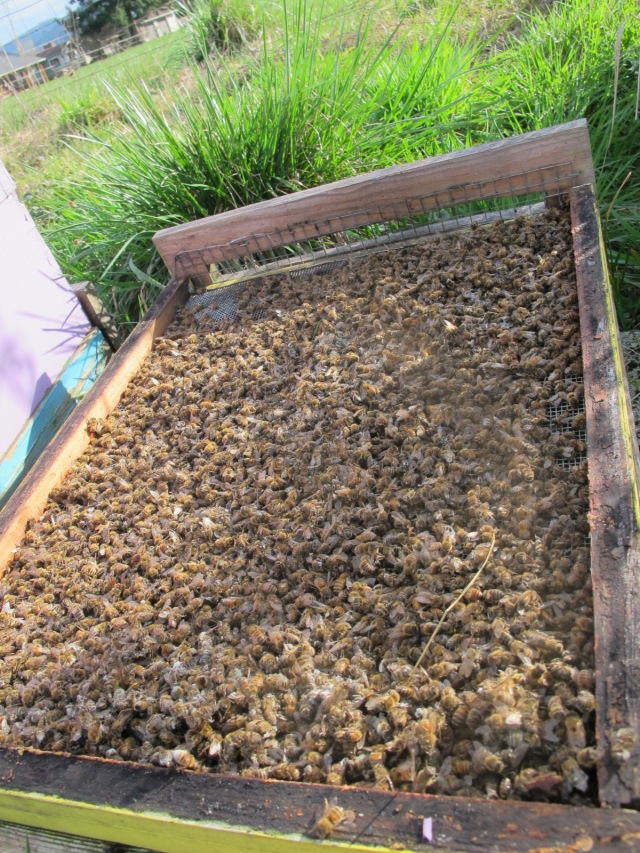

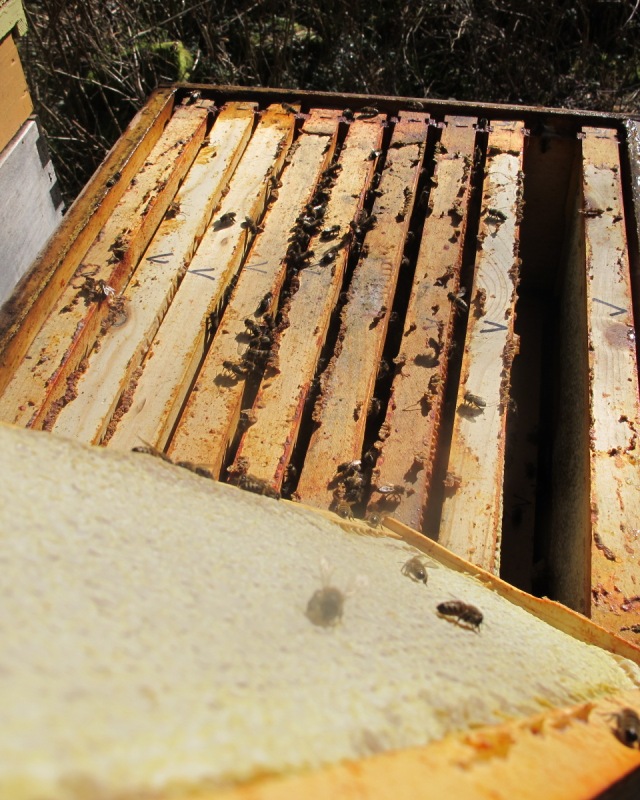
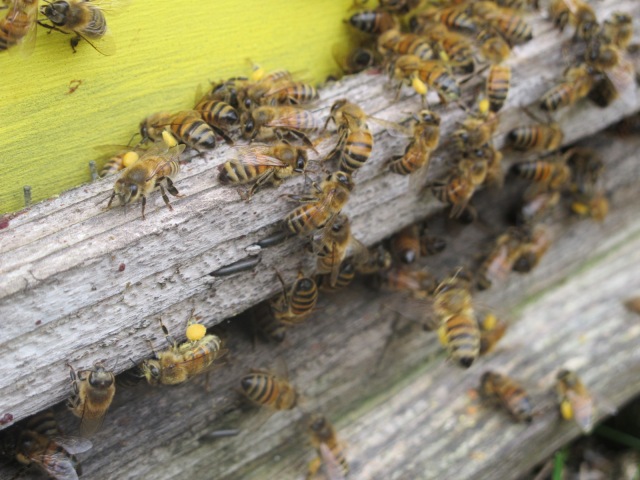
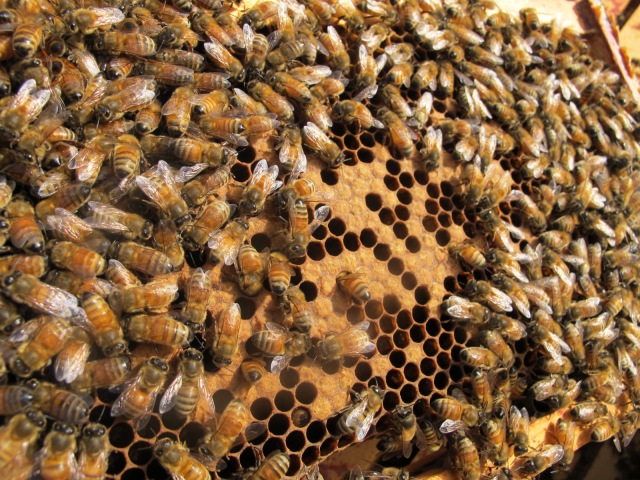
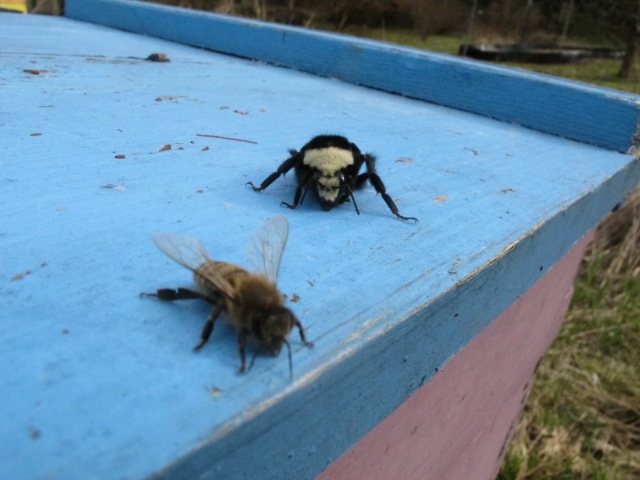
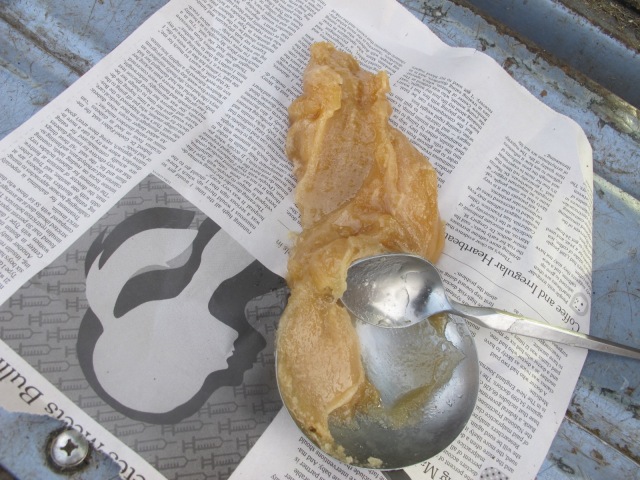
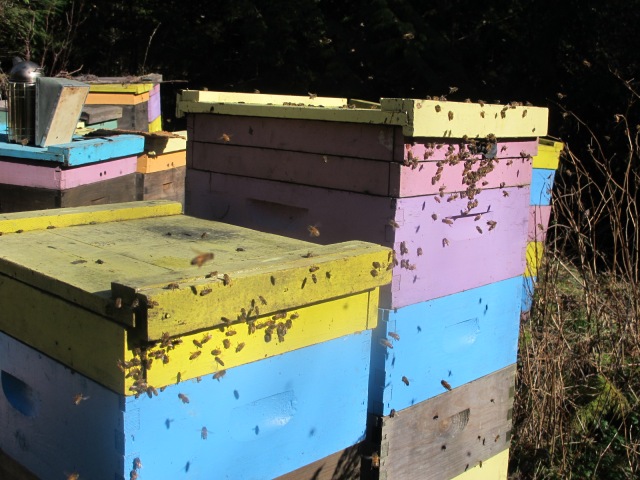







Hi Karen,
I have plated quite a few flowering plants to give any local bees something to knosh on.
I don’t know of any intentional hive anywhere near me so these must be local swarm that found someplace to build a hive. But whatever bees are around are doing a good job of pollinating. My little orange tree had several hundred tiny oranges on it and it’s only four feet tall. Too bad none of the stray cats will take care of that little chore.
Drew
Hey Drew, that’s brilliant about the bees – you’re a blessing to anyone who has a backyard hive — and a friend to those feral honey bees.
Sounds like you’re doing well overall. When I heard Norman Carreck from COLOSS (Prevention of Honey Bee COLony LOSSes) speak recently, he mentioned that lack of pollen diversity – leading to poorer nutrition – could be one reason why bees in agricultural areas don’t do so well.
That’s an interesting thought. My husband said – it’s the water (the Nooksack river is not the cleanest river once it gets to the agricultural areas). Oh, wonderful link on winter losses you did on your blog. It’s been passed around here.
Not looking too bad here in Southern England. Colonies all active and bringing in pollen, but almost running on empty. I’ll shortly switch from fondant to 1:1 syrup with a drop of thymol – this paper http://www.hrbka.org.uk/assets/site/documents/misc/thymol-for-nosema-paper.pdf
explains the rationale.
Thanks for the link – I’m a fan of thymol too.
So enjoyed this … Thank you. I gave just been debating buying a neighbors bee keeping hives and equipment but wondering if I am getting in over my head…, still debating that:) Getting bees seems to be the problem first, and keeping them going …,second?
What I would do is: 1) join the local bee club (google Beekeepers Association and your state, if you’re in the US) for a year before I bought anything. That way you can hear all the joys and traumas about beekeeping in your area and possibly visit a few hives. Plus they’d have leads on where to get packages and nucs of bees — and everyone will have a different opinion – that’s beekeeping 2) Check out SlovenianBeekeeping.com These are Eastern European hives that open from the back and don’t stack high like our US hives do. If I were to only have a few hives these are what I would have. 3) If you don’t go “slovenian” go for 8 frame westerns, your back with thank you. 4) For my 2-cents if you’re in the coastal Pacific Northwest, I’d go with New World Carniolans or Russian bees — dark bees, they take a bit more work (Russians build new queens just for fun) I think they do better up here. — I love beekeeping, but it certainly has its highs and lows……
Pingback: Post-Winter Hive Check 2016 | Brookfield Farm Bees & Honey Blog – WORLD ORGANIC NEWS
Hello Karen,
Im a new bee keeper here in WA state. I live about an hour south of you. I have two hives that made it through the winter and seem to be doing well. I am anxious to start making a few queens and split my hives. When do uou think it safe to start grafting here in our neck of the woods?
Hi Justin – Everyone chooses the time to graft (or whatever method they want to use) differently, but this is what I go by: 1) Sexually mature drones in the air (if you touch their back lightly they will vibrate) and 2) native trailing blackberries in bloom — this latter I learned at a bee meeting and it seemed to work. Some people will graft when drone brood has purple eyes – which does work well on timing. Splitting hives is kind of a “build up” thing. I’ve got one marked for split as soon as more drones are in the air – lots of bees there. Other hives are slow growing….
Just found your blog and am enjoying reading! I keep about a dozen hives here in the mountains of NC. At 3000′ and lots of rain. When I read bee keepers in the NW the rain sounds very familiar. The hives are building and there are a goodly amount of drones in the hives so I should graft in a week or so. Thanks and keep up the great work!
Thank you – You’re a lot higher up than I am, bet it’s lovely – queen rearing is kicking off around here too. Again, earlier than usual in my mind (last year was early too)…Expect the unexpected, eh?